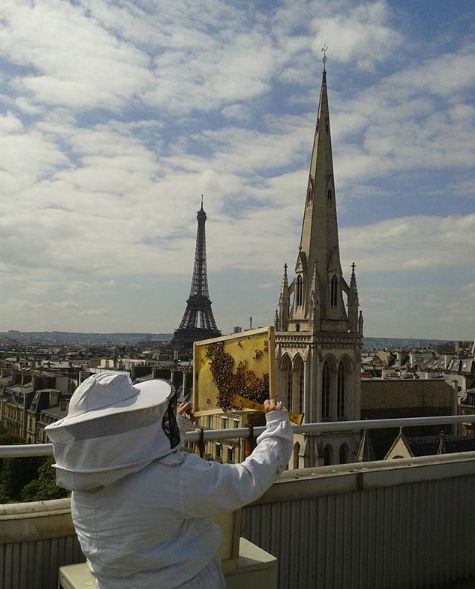
Bees have a long history in France. Napoleon Bonaparte made the bee, a sign of perseverance, passion, and hard labor, the emblem of his French empire in the 1800s. A few decades later saw the establishment of the Luxembourg Gardens Beekeeping School, which has been maintaining beehives in Paris since its founding in 1865. Actually, the city was home to an estimated 2,000 colonies at that time. After then, apiary culture declined for a while until rebounding recently, with more than 700 beehives presently operating in Paris. Unbeknownst to the general public, several of these hives are housed on the rooftops of some of the most well-known architectural icons in Paris, including as Notre Dame, the Opéra Garnier, the Grand Palais, and the Musée d’Orsay. Some are stored on the rooftops of well-known establishments like the Mandarin-Oriental and La Tour d’Argent, and chefs use the special honey to create visually stunning dishes in the kitchens below.
The quantity, quality, and flavor of the honey produced by the bees is what makes them and their product so remarkable—rather than the fact that they reside on expensive real estate in Paris. First off, it’s possible that some of the reason city bees produce three to five times as much honey than country bees is because they aren’t subjected to pesticides. Pesticides are heavily used in the countryside but are prohibited in all parks and gardens in Paris. Every year, a phenomenon known as Colony Collapse Disorder (CCD) causes up to 40% of rural French beekeepers’ hives to disappear. This phenomena can be caused by disease, chemical exposure, parasite infestation, or habitat degradation. Urban beekeepers, on the other hand, say they lose fewer than five percent of their colonies annually.
You may be thinking, “That’s all very well, but isn’t Paris really polluted?” Surprisingly, pollution does not appear to have an impact on honey (though it has been detected in beeswax). In one test, thirty contaminants were looked for in Parisian honey, but none were discovered.
In terms of flavor, Parisian apiaries have a clear edge over those in the countryside since Paris provides a wide variety of flowers and exotic plants from across the globe for the bees to eat, whereas the countryside mostly consists of monocultures. The variety of plants gives the honey a unique flavor that some have compared to cherry or bubblegum. In an interview with Secrets of Paris, Audric de Campeau of Miel de Paris said that the honey had undertones of “red fruit, lychee, citrus, and menthol.” Its flavor is so nuanced and captivating that chefs like Jérôme Banctel of La Réserve Hotel seek it out. The honey has become quite popular in Paris because of its usage by well-known chefs and the city’s tradition of supporting local businesses. However, the honey is expensive, costing around USD 65 per pound (compared to USD 12 to 23 per pound for honey from the nation).
Apart from the expense, there have been a few little issues with the apiaries. For example, too many hives in one place may result in underfed bees if there is insufficient flora, therefore beekeepers need to work together and take care not to overcrowd their colonies. One beekeeper was allegedly requested to remove his hives from Fouquet’s roof because his bees were drinking from the flower vases on the tables. Tiny winged guests are another problem at restaurants. On the other hand, if beekeepers take good care of their hives, most issues may be avoided. With cameras, microphones, and sensors that send data in real time to mobile phones, technology may also be utilized to better monitor the hives. This allows for exact and continuous surveillance.
These days, bees aren’t only buzzing across Paris. Urban beehives may also be found in Berlin, Tokyo, London, Washington, D.C., and San Francisco (but beekeeping in New York City is subject to a $2,000 fine). In an attempt to boost local bee populations and raise awareness of the global crisis of CCD, which has resulted in a startling decline in the bee population worldwide, many of these trendy hives have sprouted up in reaction to it.
So “bee” alert for some local honey the next time you’re in Paris, or even in your hometown. Watch this video of Audric de Campeau’s lectures on the École Militaire in the interim:



